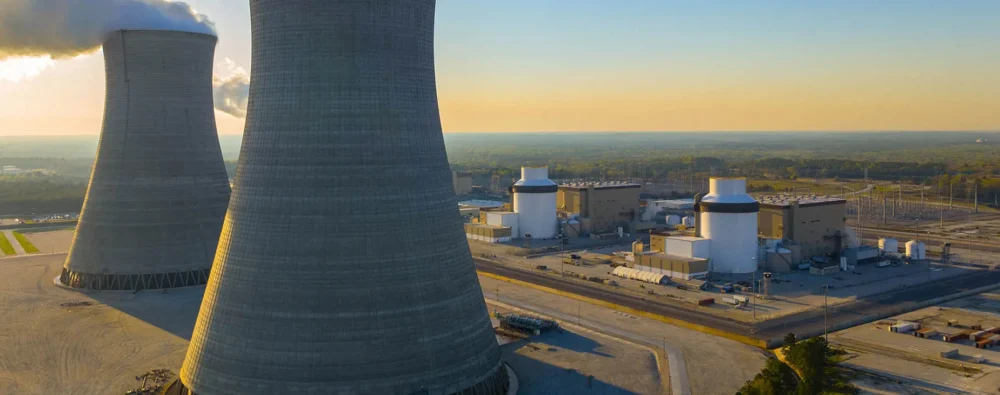The United States Government has entered a landmark partnership with Westinghouse Electric Company, Cameco Corporation (TSE: CCO) (NYSE: CCJ), and Brookfield Asset Management (TSE: BAM) (NYSE: BAM) to accelerate nuclear power deployment and strengthen the nation’s technological edge.
Under the agreement, at least $80 billion will be invested to construct new nuclear reactors across the country using Westinghouse technology, revitalizing the domestic nuclear industry.
Officials said the program will not only expand America’s energy infrastructure but also support artificial intelligence development, reinforcing national competitiveness.
Howard Lutnick, Secretary for the U.S. Department of Commerce, emphasized that the partnership will speed up the adoption of advanced nuclear technologies. He said the initiative will create high-paying jobs, boost energy independence, and strengthen critical infrastructure. “This collaboration puts American energy first and embodies the bold vision of President Trump to lead the nuclear renaissance,” Lutnick said.
Chris Wright, Secretary for the U.S. Department of Energy, noted that the project supports the president’s dual goals of energizing America and maintaining a global AI advantage. He added that President Trump had promised a nuclear revival, and this agreement marks a significant step forward.
Brookfield Asset Management President Connor Teskey highlighted the firm’s role in expanding infrastructure to meet both energy and AI needs. He said Brookfield, with more than half a trillion dollars invested in critical infrastructure, aims to double that commitment over the next decade. The investment will support Westinghouse’s nuclear projects and strengthen the U.S. energy supply.
Read more: U.S. Army launches Janus Program to deploy nuclear microreactors by 2028
Read more: Startup reimagines nuclear energy with mile-deep micro-reactor pilot
New partnership expands American nuclear supply chain
Cameco CEO Tim Gitzel emphasized that the partnership builds on the company’s existing collaboration with Brookfield and Westinghouse. He said the initiative enhances global growth opportunities for Westinghouse and Cameco while advancing energy security and climate goals.
“Cameco provides a secure, western-based supply of uranium fuel, supporting reliable operation of Westinghouse reactors in the U.S. and internationally,” said Gitzel.
The new partnership will expand the American nuclear supply chain and create tens of thousands of jobs.
Each two-unit Westinghouse AP1000 reactor project generates or sustains roughly 45,000 manufacturing and engineering positions across 43 states. A nationwide rollout could add more than 100,000 construction jobs. Consequently, the U.S. could solidify its status as a global nuclear energy leader while increasing exports of Westinghouse technology.
Once completed, the reactors are expected to provide secure and reliable electricity for both residential use and significant data center operations. These facilities, in turn, will support the country’s growth in AI, which relies on large-scale computing power.
The partnership also includes profit-sharing mechanisms. These provisions ensure that all parties, including American taxpayers, will benefit from the long-term financial and strategic gains generated by expanding nuclear power and AI investments. Additionally, the framework encourages further private-sector engagement while maximizing public value.
Industry analysts called the agreement historic, noting it represents one of the largest coordinated efforts to deploy nuclear energy in the United States in decades. Furthermore, the deal signals a broader strategy to combine energy development with emerging technologies such as AI.
Read more: Texas A&M to host first reactor in Trump’s nuclear pilot initiative
Read more: Startup reimagines nuclear energy with mile-deep micro-reactor pilot
Westinghouse a central player in energy transition
Westinghouse Electric Company’s strategic partnership with the U.S. government has already sparked significant market interest.
Analysts note that the program positions Westinghouse as a central player in the country’s energy transition. Investors are closely watching the profit-sharing arrangements. Furthermore, these provide the government with 20 per cent of cash distributions once thresholds are met. Furthermore, if Westinghouse’s valuation exceeds USD$30 billion by January 2029, the government can require an initial public offering and acquire a 20 per cent equity stake through a warrant.
The market reaction has been immediate. Cameco, which owns a 49 per cent stake in Westinghouse, saw its stock jump 27 per cent following the announcement, reflecting strong investor confidence in the partnership’s potential. Meanwhile, Brookfield experienced a 4.2 per cent increase, indicating positive sentiment toward long-term infrastructure investments for energy and AI development.
Financial forecasts show robust growth potential. Westinghouse’s adjusted earnings before earnings before interest, taxes, depreciation and amortization (EBITDA) is projected to rise at a compound annual rate of six to ten per cent over the next five years, excluding the expected $170 million boost in 2025. Analysts emphasize that these gains will largely depend on timely project execution and effective management of the construction pipeline.
.












